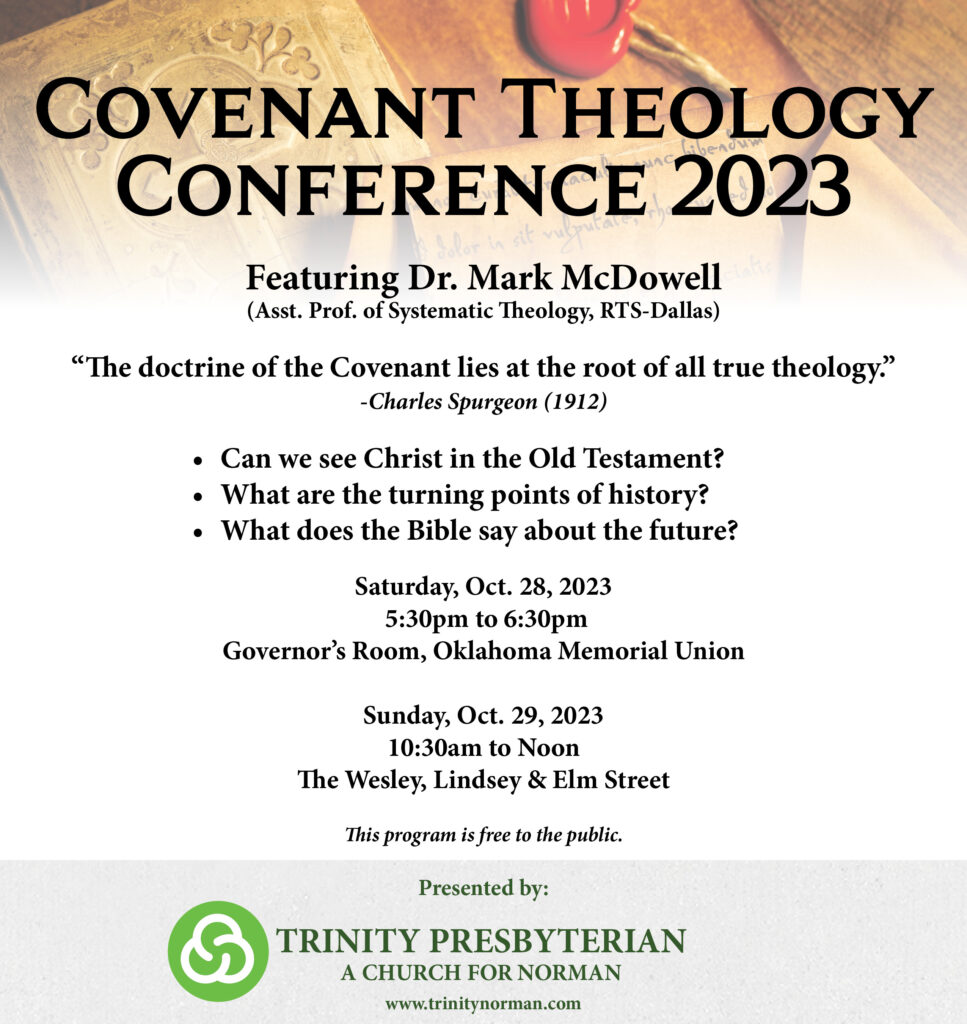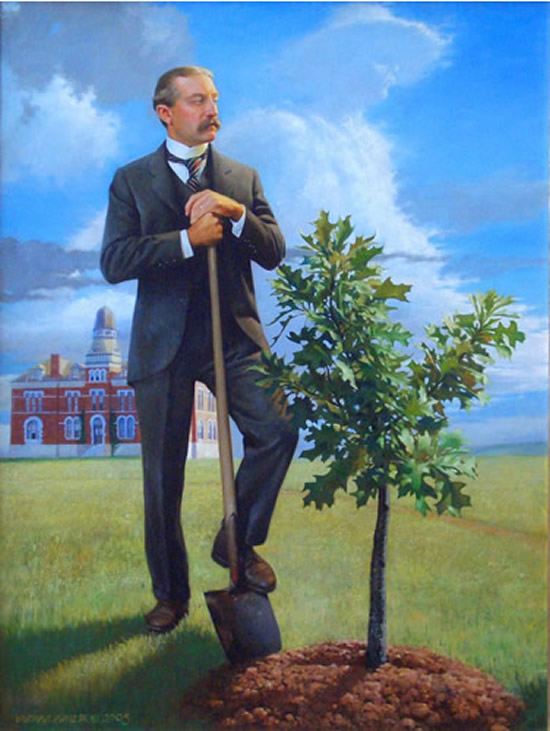
We are having a covenant theology conference! Covenant theology is something we love and one of the central tenets of a reformed Presbyterian church. Covenant theology is the grid by which we know our God, ourselves, and our place in the world. As the first church in our denomination to be planted in our state, we long for every Oklahoman to know of it.
What is covenant theology? It is the study of God’s covenants with His people. What is a covenant? A covenant is a sacred bond. It is the central analogy by which believers can comprehend their saving relationship with God through Christ by faith. As a husband and a wife encounter a unique relationship of oneness and binding commitment, so the Lord Jesus binds himself to the bride, his church (Ephesians 5:25-32). Rather than the bi-lateral nature of our marriage covenants, in salvation history, God enters into a unilateral sovereign covenant and commits himself to uphold the promises of the covenant under the penalty of death (Genesis 15). Jesus keeps both our obligations to perfectly, perpetually and personally obey all of God’s law AND pays the costly price of God’s judgment upon all sin and unbelief in his enduring the cross.
God’s covenant promise is the only sufficient explanation for why Jesus would lay down his life and endure the cross. God did not need to save a people, but he graciously entered into a covenant to save a people and accomplished it in the Son and will apply the finished work of salvation through the ministry of the Holy Spirit. This is all in accordance with the eternal decree and will of God nicknamed by theologians as the “covenant of redemption” and alluded to throughout John’s gospel (John 17:1-5).
This covenant theology energizes our church members. It is why we are excited that God has blessed Trinity Presbyterian Church with the opportunity to hold a Covenant Theology Conference in Norman, Oklahoma, Oct 28-29. While we are a young church, we were planted with a passion for bringing the God-glorifying, joy-filled, life-changing, biblical theology of the Protestant Reformation to the plains of Oklahoma. We hope this first effort at holding a theological conference in Norman will be the first of many. And it is not only a great opportunity to grow in our faith, but it is actually a day that has been in the making in our state since before we were a state.
Presbyterians in Ancient Oklahoma?
We planted this church in Norman, Oklahoma because we believe that covenant theology is necessary in Oklahoma. It is central to the theology of the Protestant Reformation which didn’t quite make it to Oklahoma until recent years. Oklahoma was the 46th state in the USA, established in 1907, previously Indian territory. Some of the members of the native tribes inhabiting Oklahoma territory in the mid-19th century had become Christians prior to their removal and arrival in Oklahoma but many had not. Many who were unconverted were removed from their tribe’s homeland by those who professed the Christian faith. In mid-19th century Oklahoma, a small remnant of believers dwelt here but no organized churches. Uprooted tribes were placed in a foreign land with geographic concerns being paramount but also the ongoing wars and battles between and inside the tribes. It was then and is still to some degree now, the “wild West” in Oklahoma. The gospel was greatly needed in our state and many were called to bring it! Following the trail of tears, Presbyterians (in 1817!) from our denomination (the ARP) and other Calvinist and Reformed churches were some of the first missionaries in Oklahoma.
Following this initial effort, Christian missions sprang up primarily in the Northeast corner and south Oklahoma. One of the first known churches in the history of Oklahoma (Wheelock Church in McCurtain County) was founded in 1831 by a Presbyterian missionary who translated the Bible and Christian writings into Choctaw. This church grew and a stone building (which still stands!) was built in 1842. Despite the auspicious start, Wheelock Church discontinued services before the beginning of the 1900s. Oklahoma historian, John Dwyer, wrote, “Into this maelstrom of emotion, confusion, bitterness, and uncertainty rode those Christian missionaries, They emerged as some of the most courageous in Oklahoma history. Scores of white missionary families, as well as single male and female missionaries, carved an indelible imprint on the Indian republics and the history of the territory and state. Large numbers of Christian Natives and African-Americans also took up the banners of this crusade.”
Dwyer opined, “Perhaps Joseph’s famous words at the end of Genesis about men meant something for evil, but God meant it for good had an application here. Multitudes of Choctaws, Seminoles, Creeks, Cherokees, and Chickasaws, battered and bereft, turned finally to Christ for salvation, from both earthly and heavenly horrors.” Throughout the 1840s and 1850s, many men and women from the tribes left their dark ancestral religious practices which were analogous to many of the Canaanite and Egyptian spirituality found reported in the pages of the Old Testament. We view this remarkable work as God’s gracious work of blessing those who blessed the true offspring of Abraham, Christ (Genesis 12:3; Galatians 3:29).
Norman and OU?
Our home, Norman, didn’t receive much attention from the earliest missionary efforts, it was a much later developing area as it was settled as part of the 200 million acres for settlement in what became known as the land rush (Monday, April 22, 1889). Some of the “Sooners” were believers. From 1892-1908, the first President of the newly founded University of Oklahoma in Norman, OK was a Presbyterian named David Ross Boyd (pictured below in the painting). Boyd led daily chapel services for what was at the time around a total of 70 students. President Boyd gave Scripture readings and preached short sermons for the students, exhorting the Sooners to be faithful followers of Christ! We can’t help but trust that Presbyterian David Ross Boyd, the inspiration for the “sower statue” on the South Oval, would be thrilled to see that seeds, which had been sown, had taken root and matured, and that a Covenant Theology Conference would be held on the campus he loved.

20th Century Church Abandoned Covenant Theology
Unfortunately, the 20th century was not a good century. It was known for its world-wide violence and secularism globally. This was felt by the church in Oklahoma particularly, and America in general. With fewer roots, it is probable that our state was less resilient to the works of the devil. Nationally, by 1923, modernism had infected the mainline Presbyterian church. Another Presbyterian from Old Princeton, J. Greshem Machen, wrote his Christianity and Liberalism, explaining that much of what was Christian in name was actually not Christian at all, but an entirely different religion from the faith and doctrine contained in the Scripture.
As churches (many Presbyterians in name) left the biblical faith in the 20th century, they moved in widely diametrically opposed directions. The so-called liberal churches became apostate: denying the scriptures’ infallibility and inerrancy, the virgin birth of Christ, and the resurrection from the dead of Jesus Christ, among many essential tenets of the Christian faith. Having abandoned doctrine for pragmatism and chasing the siren call of the academy’s approval and cocktail party respectability, many modern Presbyterian churches have abandoned the three reformed marks of the church: the right preaching of the Word of God, the right administration of the sacraments, and the right administration of church discipline. The abiding presence of these so-called churches creates a false impression that churches are non-doctrinal, have a bias against the supernatural, and are more concerned with addressing social concerns than spiritual concerns.
How could this occur? Rather than declaring the God of the covenant of grace revealed in His Word, churches in this pattern made cultural transformation the great mission. Sadly, rather than transforming the secular culture, they became conformed to the secular culture of 20th-century America. As the Lord Jesus instructed his disciples, “the church is to be in the world, but not of the world.” We pray that the Holy Spirit will renew the churches held under the captivity of modernism and they will acknowledge that Jesus never called his church to transform the world, but to be a faithful covenant people in the world as salt and light (Matthew 5:13-14).
Covenant tHeology Applied to All of Life
On the other end of the spectrum in the 20th century were the fundamentalist churches, some of the Presbyterians could also be described under this umbrella. They strongly opposed the modernist impulse and abandoned efforts at engaging the culture that the mainline churches were unsuccessfully trying to transform. In comparison to the methodology and results of the churches at the opposite end of the spectrum mentioned above, this would appear to be a good idea. However, it became a church “not of the world, but also out of this world.” In the vacuum created apart from the grid of covenant theology, Christians isolated in an enclave and disengaged from the world, the supposed “sacred/secular” dichotomy arose again (back from the dead of its earlier incarnation in Medieval monasticism). Some activities (more directly associated with ministry) were viewed as elevated in God’s eyes (contrary to 1 Corinthians 10:31!), while others less centrally wrapped up in gospel proclamation and missions were viewed as less important.
In evaluating this philosophy of ministry and life, we must say, positively, that a premium was placed on rescuing sinners via evangelism. We must commend the spirit of this. However, negatively, due to a lack of a coherent biblical, world-view, a general purposeless to the Christian life arose in the areas not explicitly evangelical beyond waiting until the Lord returns and the world goes up in flames.
Only a calling informed from the insights of covenant theology can deliver us from this. Covenant theologians draw insight for the life of the believer from the creation/fall/redemption/consummation timeline of scripture. Covenant theology affirms the dignity of work and rest as it was wrapped up in the covenant of creation (Genesis 2). Adam was given a covenant of works (Genesis 2:15-17) within his original creation mandates, yet he broke this covenant of works. Because of Adam’s breaking the covenant, the creation, which was created good (Genesis 1), was cast into a cursed existence (Genesis 3). God, however, was not abandoning it as we see in the Noahic covenant (Genesis 9:8-17), as He had promised to send help: the offspring of the woman, Eve, to destroy the works of the devil (Genesis 3:15; 1 John 3:8). This was the first promise of the second covenant, known as the covenant of grace! All of history and all of mankind live in this bi-covenantal structure…God relates to each of us according to either our status under the covenant of works in Adam or according to our status under the covenant of grace in Jesus Christ.
In the fullness of time (Galatians 4:4), God acted by sending his Son, Jesus Christ, to be the new Adam and to consecrate all of creation (Romans 5:12-21). He came in His first coming to bear the sins of his people, but He would return once again to bring a new creation (Romans 8:23), and his resurrection was the first fruits of God’s plan of salvation (1 Corinthians 15) to bring a holy people into a holy land into His holy presence. The reformed Christian under the influence of covenant theology viewed Jesus as King, and his or her calling to be “kings” in Christ and exercise dominion over whatever piece of creation which he or she was gifted and made stewards of whether in a vocation, raising family, or solving problems arising in the disorientation and chaos in a fallen world longing for redemption. Fundamentalism could not find meaning in good work or making good art, but instead sought to make everything “Christian” as an instrument of evangelism in order to rescue as many as possible from this evil world. Covenant theology, on the other hand, views work as meaningful, important worship and service to the Lord of the Covenant.
Covenant theologians affirm the spirituality of the church. The church is to be a corporate body of Christ holy/distinct from the world, yet the believers are also distinctly individuals with unique callings to engage the world/creation in all manner of lawful callings because all things were created good, and God is redeeming and preparing them to be the new creation.
Covenant life is organized according to the creation week and the resurrection of the Lord. Churches gather for covenant renewal each Lord’s Day, the first day of the week, where we meet corporately with our risen Lord. This day is to be wholly devoted to worship. Girded by the promises of covenant membership secured fully through the plan of salvation executed by the Triune God and received by faith, the covenant people partake in the blessings of the covenant of grace.
God’s covenant people then go to glorify God in the six remaining days of the week to engage in the worldly employments in which God has placed them. The covenant people are to glorify God in six days of legitimate, skillful work and one day of covenant-renewing worship. This pattern holds out to us that our lives our lived under the great program of God’s working out his covenant promises. We are reminded of this Christ-centered covenantal existence when we partake of the covenant signs and seals like the Lord’s Supper when He meets with His people to assure us of these truths. This clarity of purpose and definition is absent from both strains of the church that became prevalent in Oklahoma in the 20th century.
Covenant Theology and Baptism and the Christian Family
Without covenant theology, a believer can lapse into a “just me and Jesus” philosophy. When the gospel message is unhitched from its biblical context of covenant theology, believers are encouraged to cultivate their personal relationships with God. Without covenant theology, the bible becomes a book where Christians could “find a verse,” “life application,” or “positive and negative exemplars.” This over-emphasis on the individual and his or her own feelings and understanding impacts the assumptions one makes about one of the most recognizable rites of the church: baptism.
Christians may have little understanding of how God has always worked through families. Scripture reveals that God predestines to save some from out of the world. He then in history effectually calls a person out from the nations. But we also observe that the pattern of God calling an individual and the corporate household of all those connected to the called person is impacted (consider Noah’s family in the Ark; Abraham’s descendants, the twelve tribes descended from Jacob, the millions of Hebrews set free from Egypt through Moses, and the nation of Israel centered in Jerusalem led by David and his dynasty, even new believers in the New Testament were not only baptized by their households were baptized (Acts 16:13-15), not to mention that all believers are baptized into Christ who redeemed the household of faith (Galatians 6:10)). In the 20th century, the corporate identity was de-emphasized as a theological system arose that radically separated God’s people and how God worked throughout history: dispensationalism.
While we will address the philosophy of Dispensationalism in future posts, we must acknowledge that it really caught on in the 20th century. It is often popularized today by churches calling themselves, “New Testament churches” or those who prioritize the “red-letters” (as if Jesus was not with the Father in the beginning (John 1:1-3) and did not speak creation into existence (Colossians 1:15). The implications and problems of a functionally New Testament only understanding are too numerous to identify here, but one should acknowledge that each of the 27 New Testament books in our bibles explain the gospel of Jesus Christ as the culmination of the Old Testament, for example, “this is my blood of the covenant poured out for many for the forgiveness of sins (Matthew 26:28).” How can this make any sense apart from the greater context of continuity given to us by covenant theology?

The church and her identity and work cannot be fully comprehended apart from examining the covenant unfolded in all 66 books of the Scriptures. Tragically, unhitched from the Old Testament, ministers began to teach a radical discontinuity between the way God worked in the Old and New Testaments. The contrast that many of us were taught was as stark as to imply that God must have somehow changed! May it never be so! One of the sad applications of dispensational thinking is that the children in the Christian homes of the church were no different than pagan, non-believing children in God’s eyes. This is false.
In the Old Testament, God commanded that a son (as well as all male members of one’s household) of a believer, like Abraham, was to receive the sign of the covenant placed upon him (Genesis 17). This did not guarantee salvation or all the blessings of the covenant of grace, see Ishmael, but it was an acknowledgment of their corporate participation in the people of God and that they were set apart from the world. They were taught that the promises of God were theirs if they would take hold of them by faith like their fathers had (Genesis 17:9-14). This phraseology was echoed when Peter preached his sermon at Pentecost (Acts 2:38-29), “for this promise is for you and your offspring.”
The church was, therefore, to evangelize and disciple its youngest members baptizing them and teaching them to obey the commands of God, nurturing them in the fear and knowledge of the grace of the Lord Jesus Christ. The benefits of the work of Jesus were portrayed in the cleansing signified by circumcision in the previous era and baptism in the present era. The children of believers like Abraham’s children were not outsiders, but partakers in the covenant sign. As Jesus brought the kingdom of God, we see the continuity between the faith of Abraham and that of modern believers (Romans 4; Galatians 3:28) as children of believers are called, “holy” to the Lord, (1 Corinthians 7:14). Within the covenant people of God has always existed a mix of believers and unbelievers, Ishmael and Isaac, Esau and Jacob, those with hearts uncircumcised and circumcised hearts, but God has always used His covenant sign not as a sign of a decision made by the individuals but to set His visible people apart from the world.
This is true today. Covenant theology alone gives us a biblical understanding of church membership and the right understanding of the Christian family including the love that the heavenly Father has for the children of the church. This elevated, holy status for the children of believers in God’s eyes, makes sense of Jesus’ strong rebuke of the disciples who hindered the children from coming to him for a blessing. Jesus explained that the kingdom of God belongs to some of them (Mark 10:16), helpless babes as they might be at that point in time. Nonetheless, if any of them were chosen in Christ, he would never lose a single one of them, all who were given to Jesus by the Father would come to Him (John 6:37).
Many churches over-emphasize the role of the one receiving the baptism as a representation of what the believer has done in believing. This is commonplace in experience but it is a fundamental misunderstanding of the New Testament. In the New Testament, baptism is never described as signifying what a believer does in salvation, but what God does in salvation. It is a covenant sign and seal to be received by all believers and their children. The baptism of a child is a visual preaching of the gospel and re-naming of the individual and his or her being identified with a covenant people and promise. Baptisms are important and crucial for the very purpose that they glorify God’s gracious work of forgiving sins in Christ and uniting us to be a people in Christ by the Holy Spirit.

Covenant Theology Fuels Our Worship
Why would the children of today care about the God of scripture? They have more information on a small device in their pocket than all the members of the church combined had access to for the last 2000 years. The church must meet the unique ministry challenges today in equipping parents to disciple their children and in providing inter-generational context to grow in their faith in the wider body of Christ. The church exists to present every member complete in Christ (Colossians 1:27). The church cannot impress the children according to the flesh and it would be foolish to try. The church, however, should not be discouraged by unique challenges. The church is the only institution in creation that is founded upon an absolute promise of certain success from the lips of Jesus (Matthew 16:18). The church’s inevitable glorious success through preaching Christ crucified is such that it will confound the wisdom of the world (1 Corinthians 1-2). The church can absolutely see our children transformed if the Holy Spirit works through the ordinary Word of the Covenant/Scripture preached and the gospel proclaimed in the covenant signs of the Lord’s Supper and Baptism.
We believe that Oklahoma and the world’s blessing in the future will be brought about through meeting the Triune God in the pages of scripture. How joyful. delightful and splendid is our God. This is the God who is merciful and gracious, slow to anger, and abounding in steadfast love and faithfulness, keeping steadfast love to thousands, forgiving iniquity and transgression and sin, but who will by no means clear the guilty (Exodus 34:6). This is grasped by faith when we encounter the God of the Covenants. He is the one who sovereignty binds himself to his people.
The certainty and joy in being part of the covenant people of God is something that cannot be experienced in the world. Children need fathers and mothers whose hearts and minds are enflamed with the covenant love of the Father, the Son, and the Holy Spirit. Churches revitalized and planted that proclaim the God of covenant theology must fill the land. Children must be catechized in biblical theology in order to get the knowledge of God in them, and they must observe the hearts of the church made fully alive dwelling in the intimacy of covenant fellowship with their Lord if the gospel is to be believable and beautiful to them.
God Is On The Move in Covenant Theology
Covenant theology is spreading. The very first PCA and OPC churches (our sister denominations) were planted here recently. When Trinity was planted in 2017, our church was the first ARP church in the state. Thankfully, we now have three in OK! With several fine, reformed Baptist churches in the state and in our area, we see a bright future for reformed theology and the church in Oklahoma, with many being gathered to Christ and perfected in Christ. God is on the move, opening doors for Christ to be proclaimed here in Oklahoma. Today, we need a modern reformation, a third great awakening, or an unprecedented outpouring of the Holy Spirit.
It is with joy that we welcome a modern ARP minister and professor, Dr. Mark McDowell, from RTS Dallas, to lead us in our inaugural lecture on covenant theology. He will stand where old Presbyterian, President David Ross Boyd once stood and opened up the scriptures for the students over 100 years ago. The first lecture will be October 28, 2023 near the North Oval of campus at the Memorial Union at OU. The lecture will be followed by a time of Q&A. Our first conference will conclude at our worship service on Sunday, October 29, where Dr McDowell will preach and a luncheon will be held following the service. The service and lunch will be held near the South Oval of campus at the Wesley Foundation building where we meet each Sunday for worship, at the corner of Elm and Lindsey.
If you’re intrigued by what you’ve read above, come and grow and learn with us. You are invited to join us for this historic event in the history of our state, The Oklahoma Covenant Theology Conference 2023, October 28-29. Please join us in seeking and praying for the Lord’s work in the day as it draws near.


